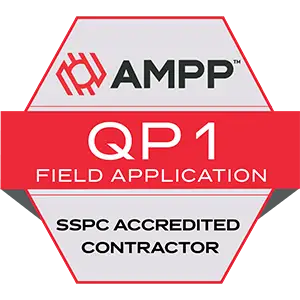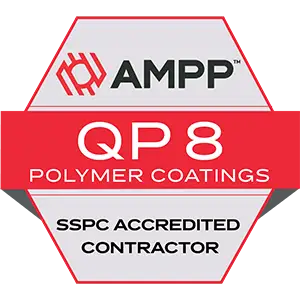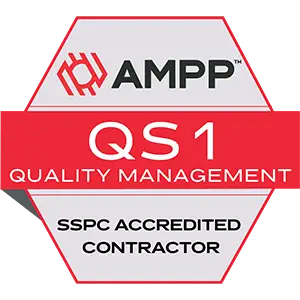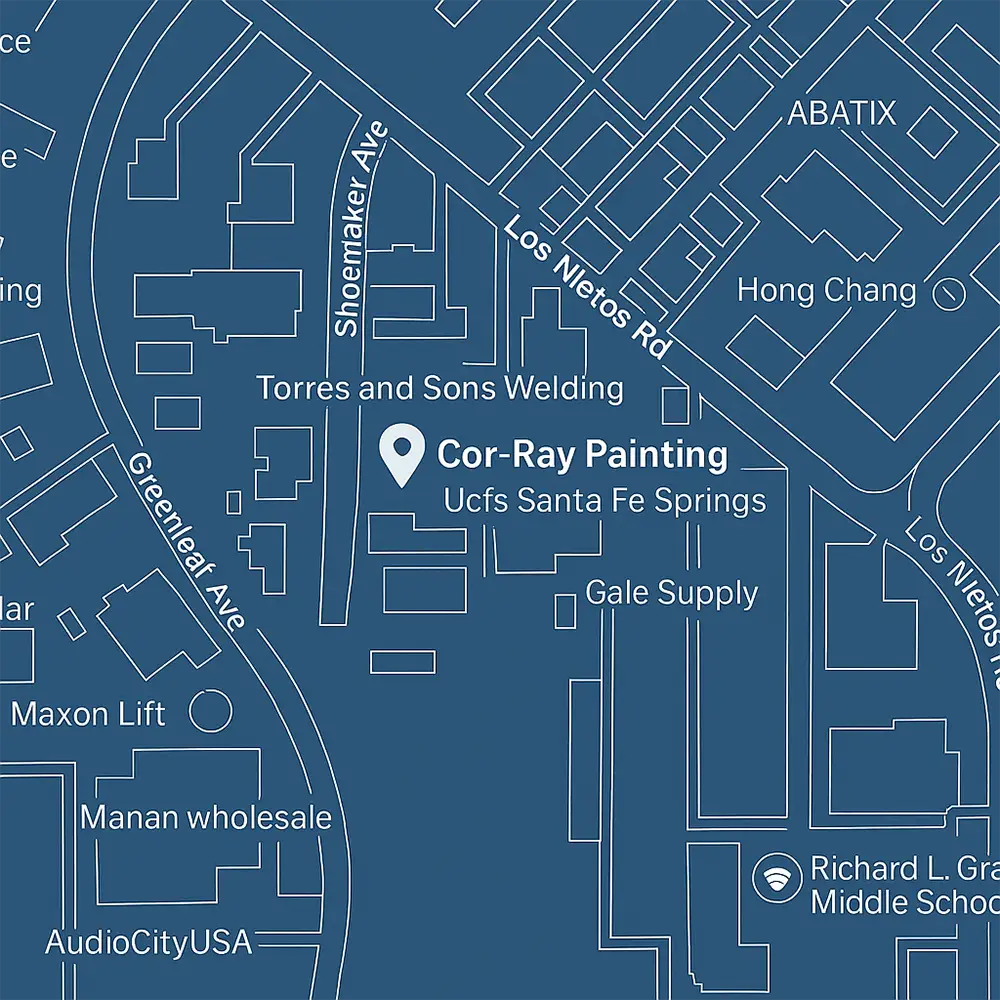As a veteran protective coating company, we understand the critical importance of quality assurance and oversight. This is especially true when it comes to designing and executing protective coating systems that safeguard infrastructure, the environment, and the public from the long-term impacts of corrosion and coating failure. That’s where SSPC certification comes in. These industry certifications signal credibility, serving as a foundation for consistent, compliant, and high-performing coatings work across a wide range of industries.
So what exactly do these certifications cover, and why are they critical to project execution and performance? Let’s break it down.
What Is SSPC Certification?
Founded in 1950, the Steel Structures Painting Council was a non-profit professional society focused on the use of protective coatings to protect industrial steel structures. As the industry evolved, so did the organization. In the late 1990s, it became SSPC: The Society for Protective Coatings, reflecting broader advancements in coating technologies and a growing focus on various materials beyond steel.
The Society for Protective Coatings developed SSPC certifications to establish consistent standards of quality, safety, and professionalism in the protective coatings industry. They help ensure that contractors, inspectors, and workers are qualified and properly trained in key areas of the coating process, including industrial painting, surface preparation, and coating inspection. SSPC certifications help provide assurances that the work meets industry-recognized standards, which is critical for long-term value, as well as in safety-sensitive and highly regulated environments.
Why SSPC Certification Matters in the Coatings Industry
Selecting the right company for a protective coatings project isn’t always straightforward for facility owners and specification writers. It can be challenging to determine which companies and contractors are truly qualified to handle the job with so many variables at stake, like project complexity, safety concerns, environmental conditions, and long-term performance. However, SSPC certifications can serve as a powerful qualifier by enhancing trust, ensuring regulatory compliance, and validating skill level. Why? SSPC-certified individuals, including industrial painting contractors, QA/QC inspectors, and project managers, have demonstrated that they meet the rigorous industry standards for surface preparation, coating application, safety practices, and inspection protocols, ensuring alignment with best practices and regulatory requirements.
In industries where coatings are mission-critical, like marine, pipeline, industrial infrastructure, and wastewater, SSPC certification assurance can mean the difference between long-term asset protection and costly failure.
SSPC Certification Types and Their Requirements
The following provides more details about a few of the SSPC certifications, including what they cover, who they are for, and the key requirements involved.
QP 1 – Field Application of Coatings
The QP 1 accreditation is the industry’s benchmark for certifying a contractor’s ability to perform high-quality surface preparation and coating application in the field. The program provides a means to determine whether a painting contractor is qualified to handle complex industrial and marine structure coatings, including bridges, food and beverage facilities, offshore drilling, power generation facilities, petro/chemical plants, storage tanks, ship maintenance, and wastewater treatment facilities. Key requirements include:
- A formal quality control program
- Documented safety procedures and compliance with OSHA standards
- Verified technical capabilities and equipment suitable for industrial and marine structures
- Qualified personnel with proper training and experience
- Proven performance on complex projects, such as bridges, storage tanks, power plants, offshore structures, and water/wastewater facilities
QP 2 – Industrial Hazardous Paint Removal
QP 2 accreditation builds on QP 1 and certifies an industrial contractor’s ability to safely handle and remove hazardous coatings when working on complex industrial and marine structures, like bridges, food and beverage facilities, off-shore drilling, power generation facilities, petro/chemical plants, storage tanks, ship maintenance, and wastewater treatment facilities. QP 1 accreditation is a prerequisite for QP 2, so in addition to meeting the QP 1 standards, contractors must also demonstrate:
- Compliance with environmental regulations (e.g., EPA, RCRA)
- Hazardous waste handling and disposal procedures
- Worker protection measures, including respiratory protection and medical monitoring
- Site-specific safety and environmental protection plans
- Experience with hazardous coating removal on industrial structures (as listed above)
PCS – Protective Coating Specialist Certification
The Protective Coating Specialist Certification, now known as the AMPP Protective Coating Specialist Certification, is designed for experienced professionals who oversee the planning, design, and management of protective coating projects. It recognizes their knowledge and skills in preventing corrosion and coating failure, while protecting public safety and infrastructure throughout the asset’s life. PCS certification is ideal for engineers, specifiers, and asset owners seeking to align coating system performance, design, application, and inspection. Key requirements include a deep understanding of coating technologies, failure analysis, specification review, and project management.
Other SSPC/AMPP Certifications (e.g., QP 3, QP 5, CAS, NAVSEA)
In addition to well-known programs like QP 1 and QP 2, AMPP (formerly SSPC) offers a variety of other certifications that cover specialized areas of the protective coatings industry.
- QP 3 – Shop Application of Protective Coatings: QP3 applies to coatings applied in a controlled shop environment vs. the field.
- QP 5 – Coating and Lining Inspection Companies: QP 5 is certification for companies providing third-party coating inspection services.
- CAS – Coating Application Specialist Certification: The CAS certification recognizes individual workers who apply coatings, emphasizing hands-on skills and knowledge of surface preparation, mixing, application techniques, and safety protocols.
- NAVSEA Certifications: Developed for military and shipyard work, NAVSEA (U.S. Navy) certifications address requirements for coating professionals working on naval vessels.
How to Become SSPC Certified
Obtaining certification is a clear way to stand out in a competitive industry and demonstrate that your work meets the highest professional standards. While the specific requirements vary depending on the certification type, here’s a general step-by-step overview of what to expect:
- Check the prerequisites to ensure qualification.
- Submit your application through the certification website. (AMPP)
- Complete the required training and documentation.
- Pass the examination where it applies.
- Undergo an Audit (for company certifications).
- Maintain and renew your certifications.
SSPC Certification vs. AMPP Credentials
In 2021, two of the leading organizations in the protective coatings and corrosion control industries, the Society for Protective Coatings (SSPC) and NACE International, officially merged to form a single, unified organization: the Association for Materials Protection and Performance (AMPP). The goal of the merger? To streamline standards, training, and certification programs across the industry and create a single, globally recognized authority for coatings and corrosion professionals. As a result, AMPP now administers all certifications.




What Happens to Legacy SSPC Certifications?
For now, your SSPC and NACE certifications are still valid under AMPP. Moving forward, AMPP is working on evolving and integrating overlapping certifications from both legacy organizations into unified programs.
Benefits of Being SSPC Certified
SSPC certification offers real, tangible advantages in the protective coatings industry for both individuals seeking to advance their careers and companies seeking to secure more business. Obtaining certifications offers several benefits, including gaining a competitive edge, demonstrating compliance with industry standards, earning industry recognition, and enhancing professional credibility. In the protective coatings industry, SSPC Certifications are not just a credential – they are an investment in future opportunities. These globally recognized certifications build trust with clients, partners, and peers in the field.
As protective coatings specialists, we know that quality and safety are essential. That’s why we’re proud to be AMPP QS-1, QP 1, and QP 2 certified, and why many members of our team hold advanced individual certifications as well. These credentials reflect our deep commitment to delivering reliable, compliant, and high-performing coatings on every project.
Cor-Ray Painting's Certifications
Learn more about Cor-Ray Painting’s certifications, capabilities, and the standards that drive our work.
Frequently Asked Questions About SSPC Certification
What is SSPC certification?
SSPC certification verifies that individuals or companies meet the industry standards for quality, safety, and performance in protective coating applications.
How do I get SSPC certified?
You must meet eligibility requirements, submit an application, complete required training or documentation, and pass an exam or audit (depending on the certification).
What’s the difference between QP 1 and QP 2?
QP 1 certifies contractors for the field application of coatings on complex structures. QP 2 builds on QP 1, adding qualification for the safe removal of hazardous coatings.
Is SSPC still active after merging with AMPP?
SSPC merged with NACE to form AMPP in 2021. All SSPC certifications are still valid and are now managed under AMPP’s unified credentialing system.
How long does SSPC certification last?
Most certifications are valid for 3 years, with ongoing audits or continuing education required to maintain them.
What is QS-1 certification?
QS 1 is the standard procedure that requires participating contractors to implement and document more stringent (ISO 9001-compliant) quality control and record-keeping procedures compared to those included in QP 1, QP 3, etc. To apply for and attain QS 1 accreditation, a contractor must already have QP 1, QP 3, QP 6, or QP 8 accreditation.



